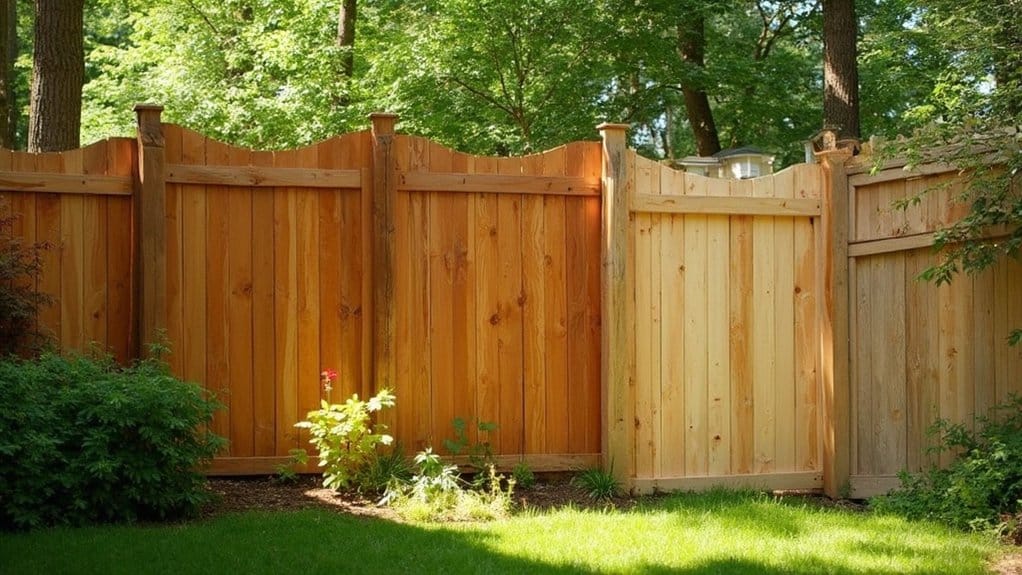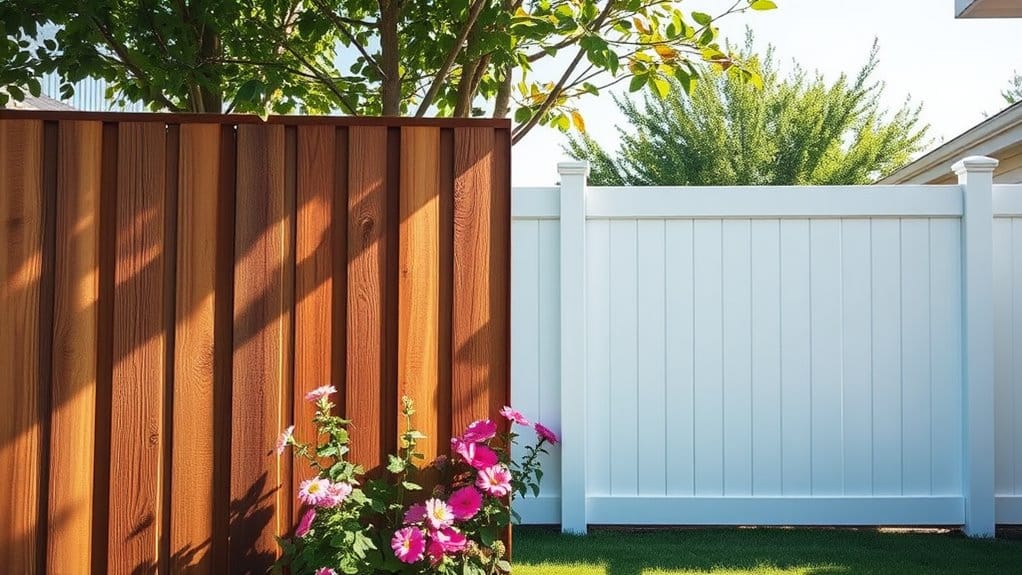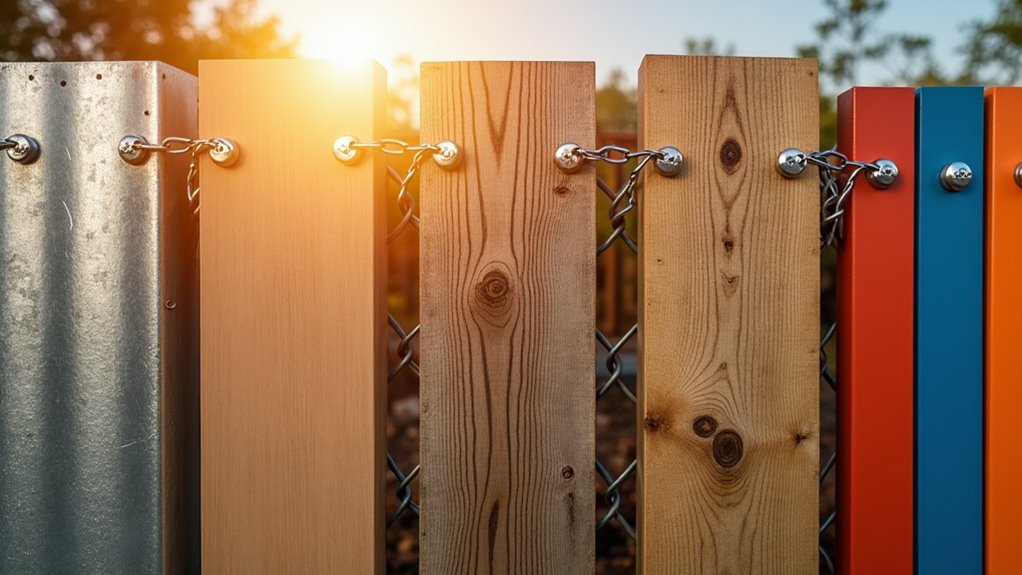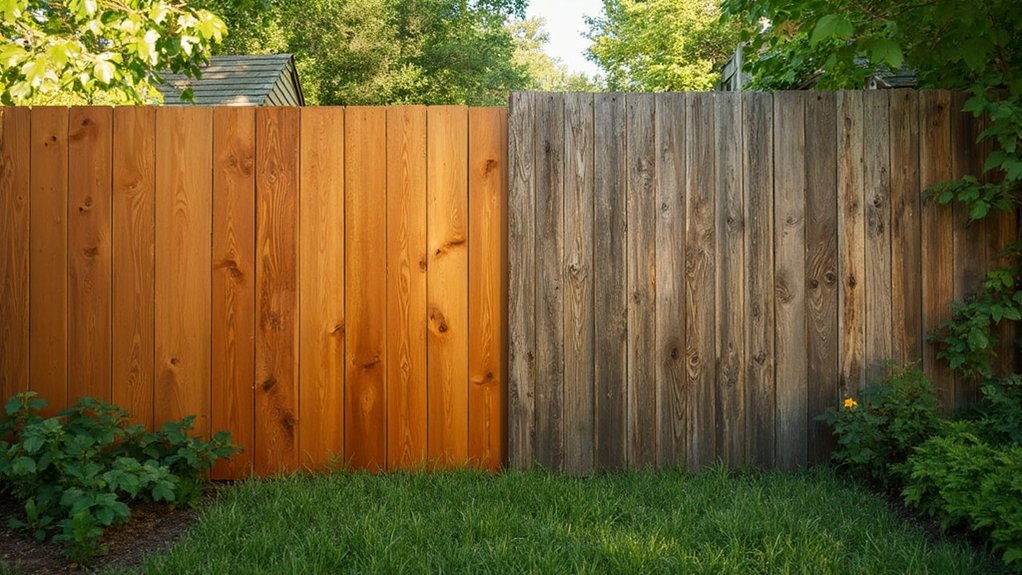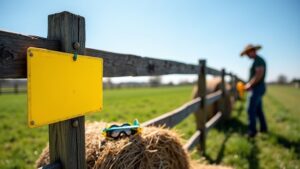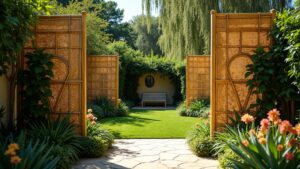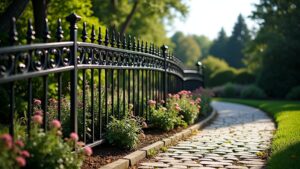When choosing wood for fencing, think about durability, look, and local climate. Cedar and redwood resist decay naturally and have attractive grain patterns, while southern yellow pine is a more affordable option. Coastal redwood is ideal for humid areas. For long-lasting fences, Ipe can last up to 75 years. Each wood type has different maintenance needs and costs, so explore your options to find the best fit for your style and environment.
Key Takeaways
- Cedar is visually appealing and naturally resists decay, lasting 15-20 years with little upkeep.
- Redwood features rich colors and is moisture-resistant, making it great for humid areas, with a lifespan of around 20 years.
- Pressure-Treated Pine is cost-effective but needs treatment to last, typically surviving 10-15 years with care.
- Ipe is a top-tier choice, known for its durability and can last up to 75 years, fitting for various climates.
- Cypress thrives in humid conditions thanks to its natural oils, offering both durability and beauty with low maintenance.
Understanding Wood Durability for Fencing
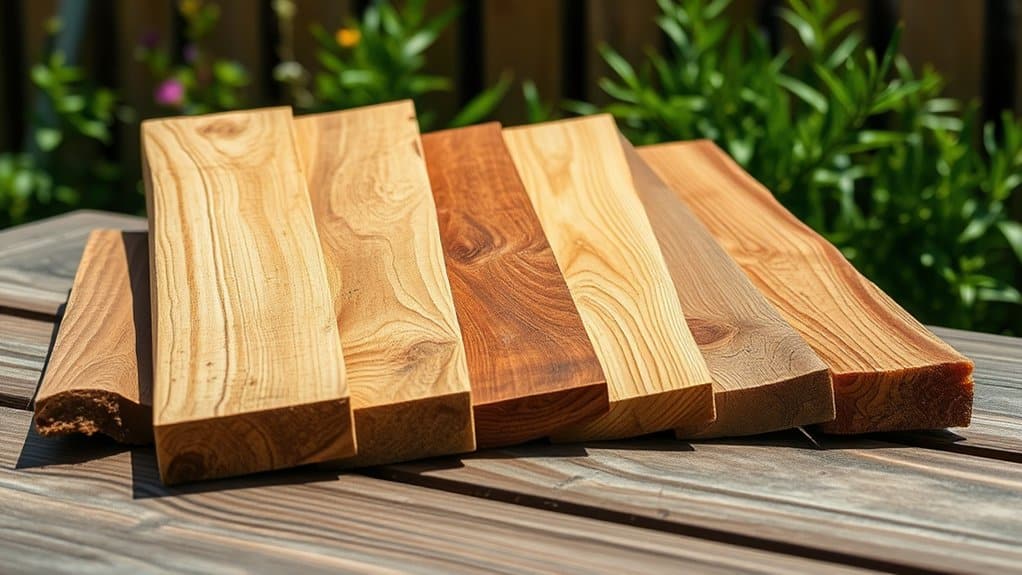
When choosing wood for your fence, durability is key to ensuring it lasts. Different types of wood vary in longevity; for instance, cedar and redwood resist decay naturally, while pine needs treatment to last longer. Natural durability ensures that wood designed by nature can withstand the elements effectively. Additionally, proper maintenance practices such as sealing or staining can extend the lifespan of your wooden fence significantly. Climate plays a role too—humidity and temperature extremes can impact durability, so pick wood suited for your area. Regular maintenance, like sealing and staining, is crucial for extending your fence’s lifespan. Address repairs quickly to avoid more extensive damage.
A sturdy, well-maintained fence not only protects your property but also boosts its value.
Aesthetic Appeal of Various Wood Types
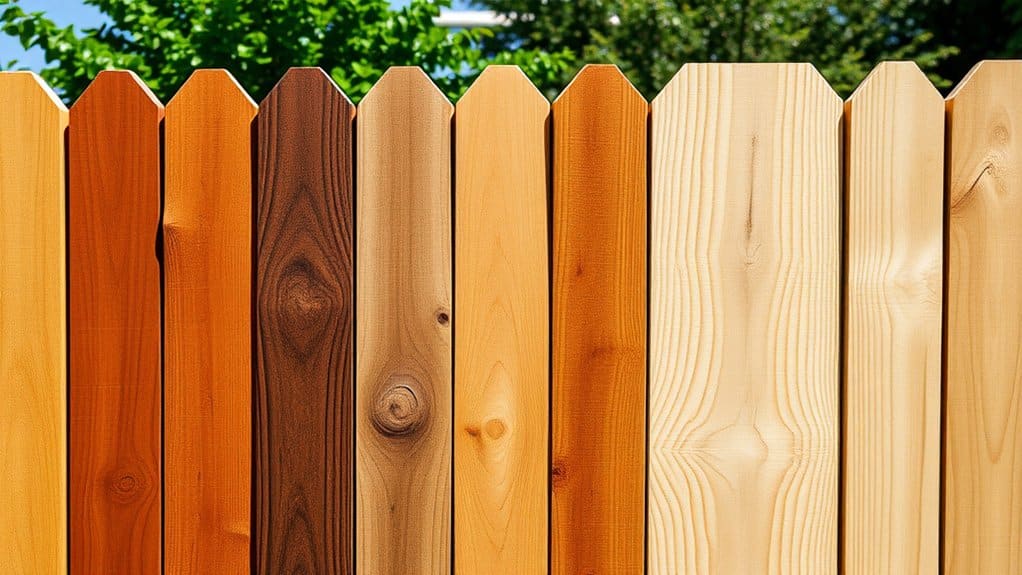
[Cedar wood fencing stands out with its reddish-brown color and fine grain, adding a beautiful touch to your yard. Redwoods, with their rich red-brown hue and elegant patterns, offer a classic charm that enhances any outdoor area. Both choices boost your landscape’s appeal and draw admiration. Additionally, these woods are known for their durability and rot resistance, ensuring that your investment lasts for years to come. Choosing the right wood type can significantly impact your fence’s lifespan expectations and overall value.
Natural Beauty of Cedar
Cedar wood is popular among homeowners and designers for its beautiful warm colors and unique grain patterns, which enhance the visual appeal of any property. Its shades range from light amber to deep caramel, making it easy to match with both traditional and modern designs. Additionally, cedar wood’s natural durability allows it to withstand harsh weather conditions without losing its charm.
Over time, cedar develops a lovely silvery-gray patina that adds character and a timeless look. The wood’s organic texture, with its distinct knots and swirls, gives your fence an authentic touch. As a result, cedar is often considered one of the most common fencing options, making it a reliable choice for many homeowners.
Cedar is also an eco-friendly choice; it’s a renewable resource that naturally biodegrades. With minimal maintenance and impressive durability, cedar not only enhances your space but also positively impacts the environment, making it an excellent fencing option.
Timeless Appeal of Redwood
Redwood is a top choice for fencing due to its beautiful color variations and unique grain patterns. Ranging from light cherry to deep reddish-brown, redwood enhances any outdoor space. Each fence is one-of-a-kind, adding charm to your property.
It’s versatile too, suitable for privacy, picket, or horizontal styles. Sourced from responsibly managed forests, redwood is eco-friendly and biodegradable.
It ages gracefully, turning a distinguished silver-gray, and requires minimal maintenance, making it a long-lasting and appealing option for your fencing needs. Additionally, redwood fencing can be complemented by the durability of PVC fences, offering an alternative that lasts significantly longer.
Climate Resilience and Environmental Considerations
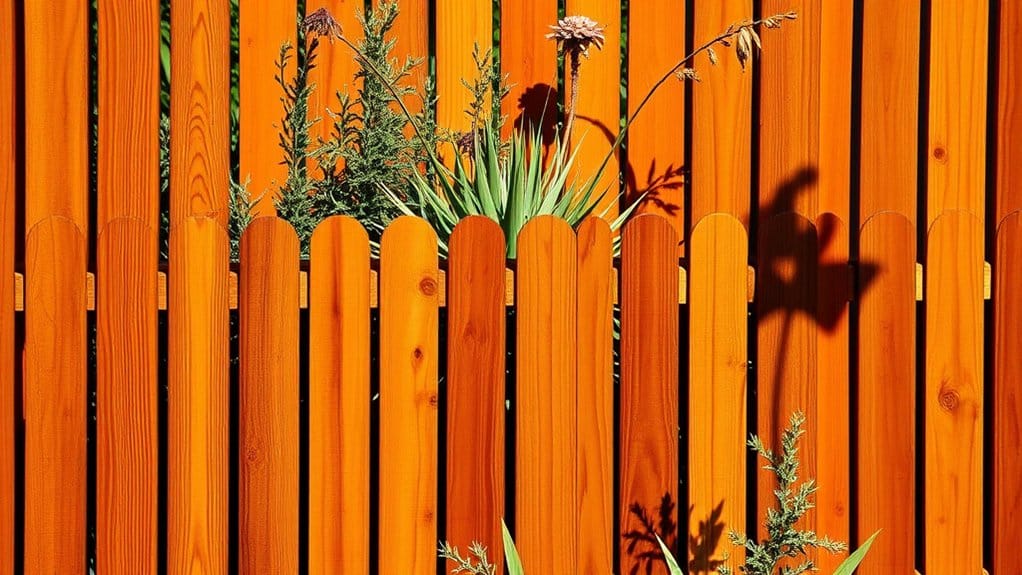
Choosing the right wood for fencing is crucial for both durability and environmental sustainability, especially as climate resilience becomes a priority.
Cedar and redwood are excellent choices for various climates due to their natural oils, while cypress is ideal for humid areas.
For eco-friendly options, consider black locust or FSC-certified woods, which are sustainable and durable.
Avoid pressure-treated wood, as its chemicals can harm the environment.
Reclaimed wood not only looks great but also helps reduce waste.
Ultimately, your wood choice can showcase your commitment to sustainability and the long-lasting strength of your fence.
Budgeting for Your Fencing Project
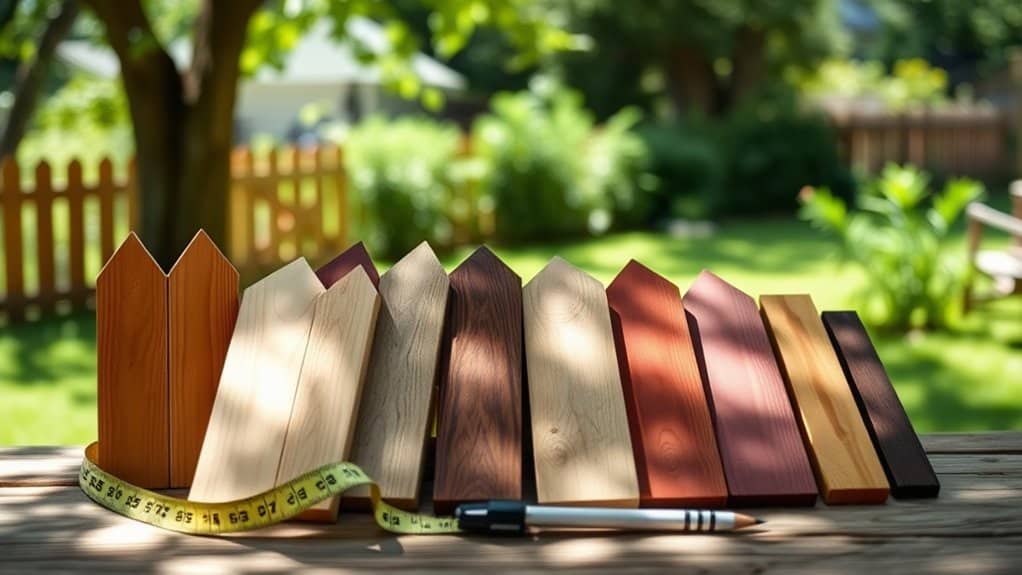
When planning your fencing project, it’s crucial to understand your budget.
Start by estimating wood costs, which typically range from $10 to $30 per linear foot based on the type of wood.
Don’t forget to include labor costs, usually between $5 to $15 per foot for professional installation.
Using cost estimation tools can help you avoid ordering too much material.
It’s also a good idea to get multiple quotes from contractors to find the best deal.
Remember to factor in additional expenses like permits, site preparation, and gates. Additionally, consider that long-term maintenance costs can significantly impact your overall investment in the fencing project.
Maintenance Requirements for Different Woods
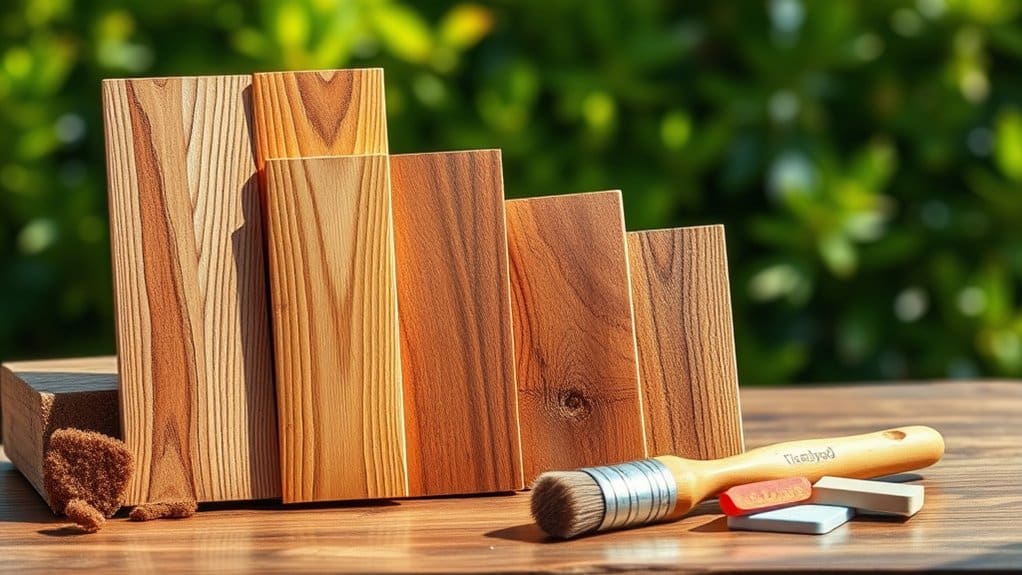
When selecting wood for your fence, it’s crucial to know the maintenance needs of cedar, redwood, and spruce.
Cedar is naturally resistant to decay and requires less upkeep, making it a great choice for low-maintenance fencing.
Redwood is also durable and needs minimal care, offering excellent longevity.
In contrast, spruce requires more attention, including regular treatments to keep it looking good and lasting longer.
Choose wisely based on how much time you’re willing to invest in maintenance.
Cedar Maintenance Benefits
When selecting wood for your fence, cedar stands out due to its maintenance advantages. It lasts 15 to 25 years with little effort, thanks to its natural oils that fend off rot and insects.
| Maintenance Task | Frequency | Benefits |
|---|---|---|
| Annual Cleaning | Every 1-2 years | Keeps the wood looking vibrant |
| Sealant Application | Every 3-5 years | Guards against moisture damage |
| Inspections | Twice a year | Catches any damage early |
Redwood Care Tips
To keep your redwood fence looking great and lasting longer, regular maintenance is key.
Clean your fence once a year by removing debris with a metal putty knife or brush. Check for loose boards and secure them using galvanized screws. Use a stiff brush to scrub along the grain, preserving its natural beauty.
Every 3-5 years, apply a redwood sealant to protect against moisture and enhance durability. While redwood has natural insect resistance, keeping vines off helps prevent moisture buildup.
Follow these tips, and your fence will maintain its stunning reddish-brown color for years, adding beauty and functionality to your property.
Spruce Treatment Necessities
Spruce fencing requires regular treatment and maintenance to last. To extend its life, consider pressure treatment with preservatives, which boosts resistance to insects and rot, making it suitable for tough conditions.
Inspect your fence annually for decay or damage, and clean it with a soft brush and mild soap. In spring, apply a water-repellent sealant to block moisture.
Remember to reapply protective finishes periodically to keep your fence looking good and sturdy. With proper care, your spruce fence can last up to 20 years, combining beauty and functionality.
Lifespan Expectations of Wood Fencing
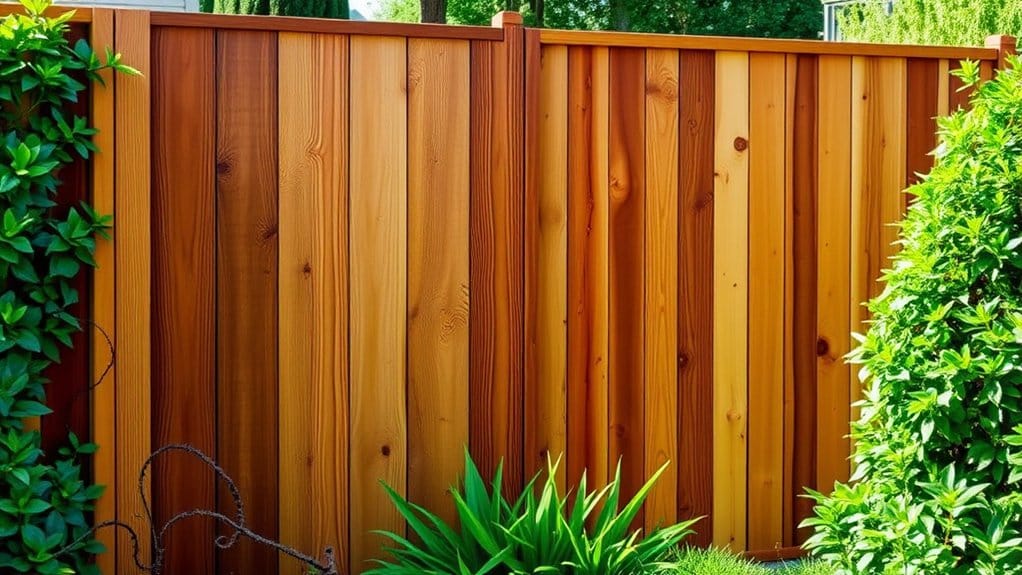
Understanding the lifespan of wood fencing is crucial for your investment. Different wood types offer varying durability, as shown in this comparison:
| Wood Type | Lifespan |
|---|---|
| Pressure-Treated Pine | 10 – 15 years |
| Cedar | Up to 20 years |
| Ipe | Up to 75 years |
| Cumaru | Over 50 years |
| Tigerwood | Over 30 years |
Factors like climate, maintenance, and installation quality affect longevity. Regular cleaning, staining, and inspections can help extend your fence’s life. Choose wisely to enjoy a beautiful and functional fence for years to come.
Western Red Cedar: The Classic Choice
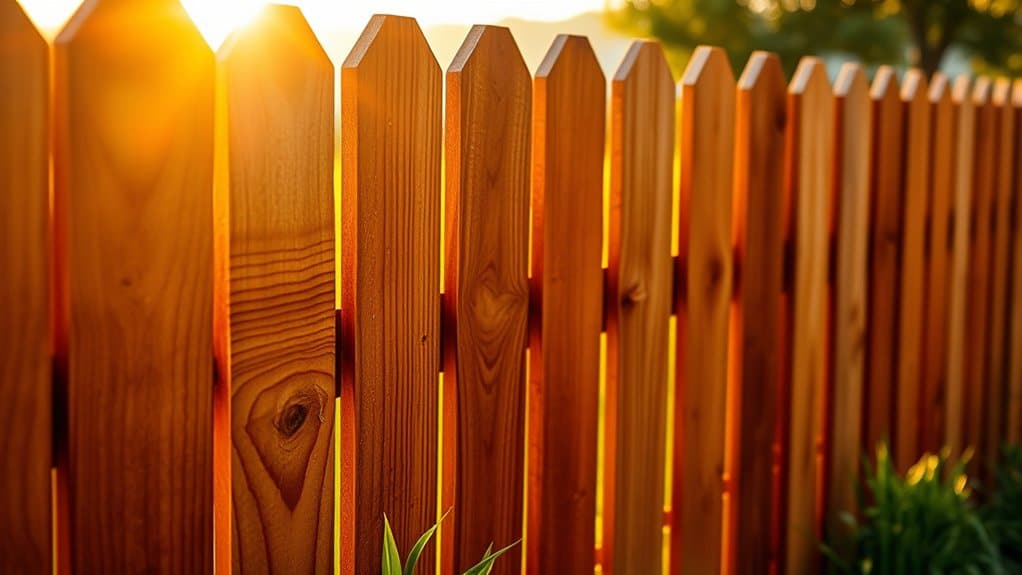
Western Red Cedar is an excellent choice for fencing due to its natural resistance to rot, which protects your investment.
Its attractive colors, ranging from light amber to deep honey brown, enhance any landscape.
Plus, it requires minimal maintenance, allowing you to enjoy your fence without constant upkeep.
Natural Rot Resistance
When choosing wood for fencing, consider Western Red Cedar for its natural rot resistance. Here’s why it stands out:
- Natural oils protect against decay and pests.
- It lasts 15-20 years with proper care.
- Responsibly sourced cedar has a lower environmental impact.
- DuraCedar’s Durezyme™ treatment enhances its rot resistance.
- It’s a durable option compared to chemically treated woods.
Western Red Cedar is a reliable choice for a long-lasting fence.
Aesthetic Appeal
Western Red Cedar is known for its durability and natural resistance to rot, making it a great choice for fencing.
Its warm hues, from light amber to rich reddish-brown, complement various design styles effortlessly. The wood’s natural grain adds a touch of rustic charm, while its adaptability allows it to fit both traditional picket fences and modern horizontal panels.
Left untreated, it ages into a beautiful silver-gray patina. For added visual appeal, consider using wood finishes that enhance its depth, ensuring your fence remains an eye-catching feature for years.
Minimal Maintenance Needs
Choosing Western Red Cedar for your fence means less maintenance for you. This wood is known for its durability and effortless care.
Here’s what you can expect:
- Natural resistance to rot, decay, and insects thanks to its natural oils.
- Weatherproof, handling rain and sun without much damage.
- Long-lasting, with a lifespan of 16 to 20 years if cared for properly.
- Easy cleaning every 1-2 years to keep it looking good.
- Occasional sealing boosts moisture resistance and protects it from the elements.
In short, Western Red Cedar is a smart choice for a low-maintenance fence.
Coastal Redwood: Beauty Meets Durability
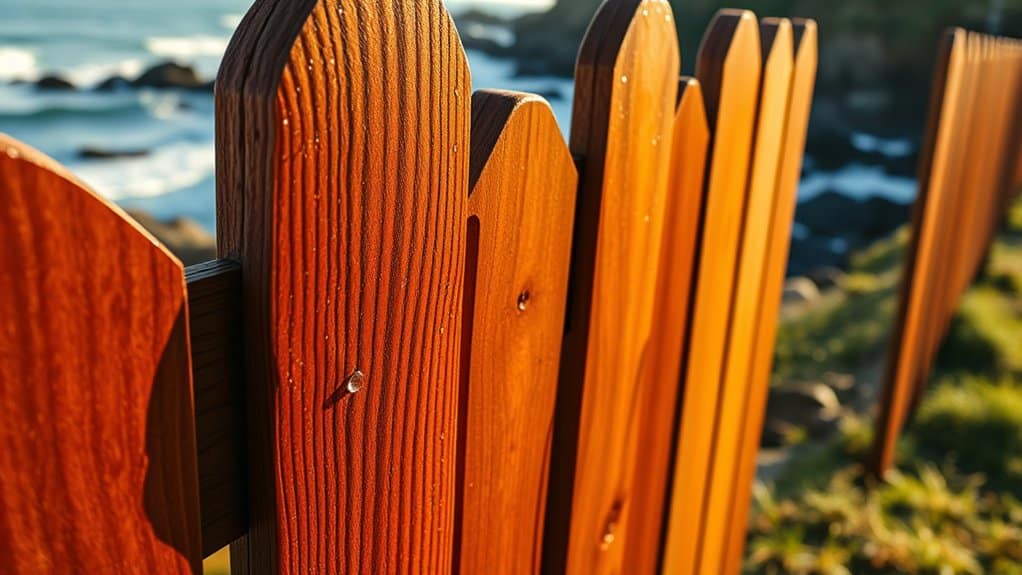
Coastal redwood fencing is a top choice for homeowners because of its beauty and durability. Its colors range from pale pink to deep reddish-brown, adding charm to your outdoor space.
The straight grain patterns create visual interest, while the coarse texture brings out those stunning details. Redwood naturally resists moisture and pests, making it ideal for humid areas.
This low-maintenance option means you can enjoy your fence without constant upkeep. Plus, by choosing sustainably sourced redwood, you enhance your property’s appeal and reduce your carbon footprint.
Southern Yellow Pine: Affordable Strength
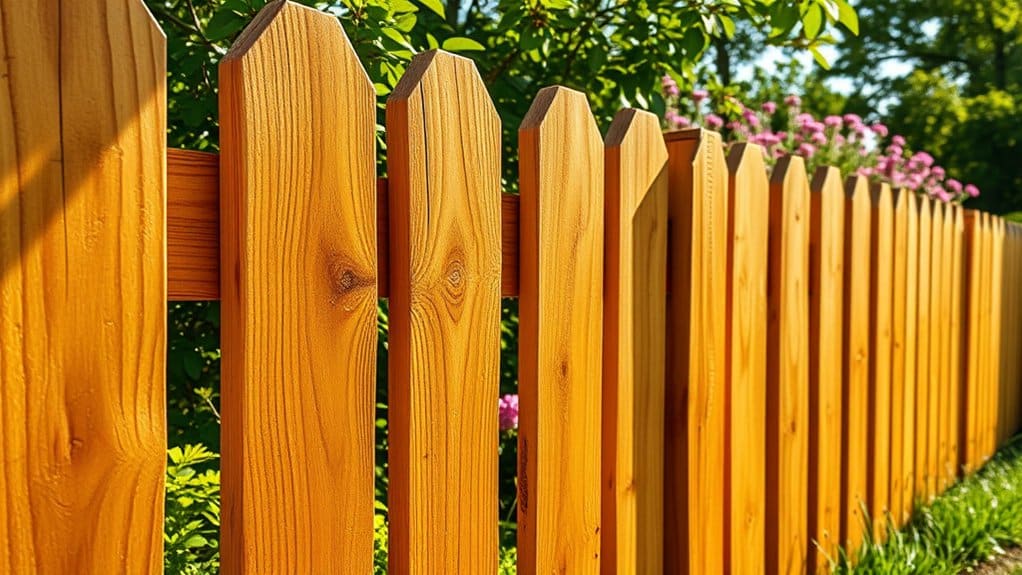
Southern Yellow Pine is a strong and budget-friendly choice for fencing, making it perfect for homeowners looking for quality without breaking the bank. Here’s why it stands out:
- Its high density offers excellent strength for supporting loads.
- It’s easy to cut and install, simplifying the setup process.
- While it’s naturally less resistant to decay, pressure treatment significantly boosts its durability.
- The wood features attractive yellowish-brown to reddish-brown hues, enhancing visual appeal.
- When treated, it has great moisture resistance, suitable for different climates.
Choosing Southern Yellow Pine means you’re getting a solid, cost-effective material that combines strength and beauty.
With regular maintenance, it will stay functional and attractive for years.
Norway Spruce: Cost-Effective Option
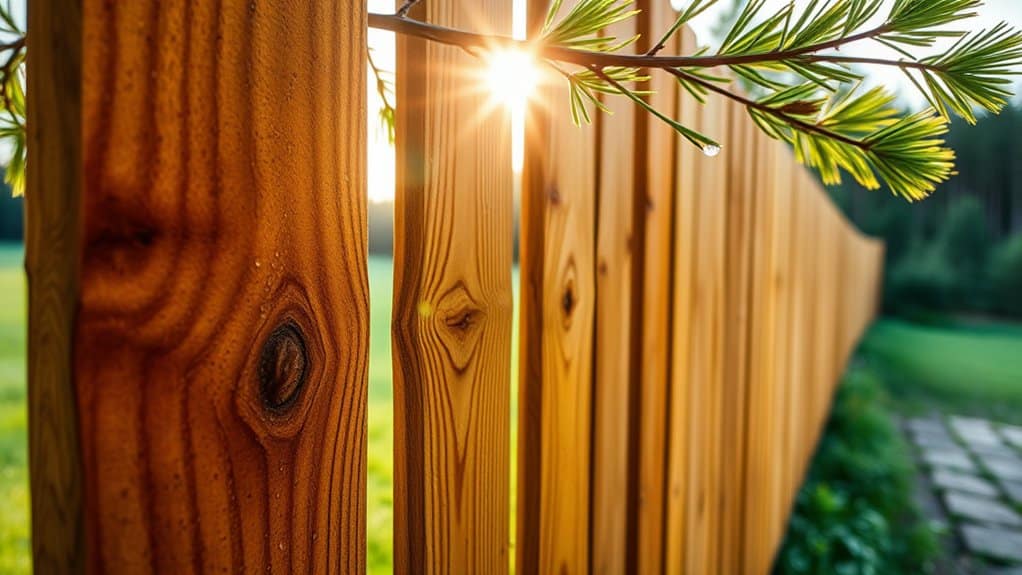
If you’re looking for a strong and affordable fencing option, Norway Spruce is a great choice.
It’s durable and works well for stockade-style fences. One of its main advantages is its cost-effectiveness, especially when compared to more expensive woods like cedar.
Although it needs preservative treatment to fend off rot and insects, its quick growth ensures a steady supply.
With regular maintenance, such as re-staining, you can keep it looking good for years. Plus, it adapts well to different soil types, making it versatile for various fencing projects.
Douglas Fir: Strength and Versatility
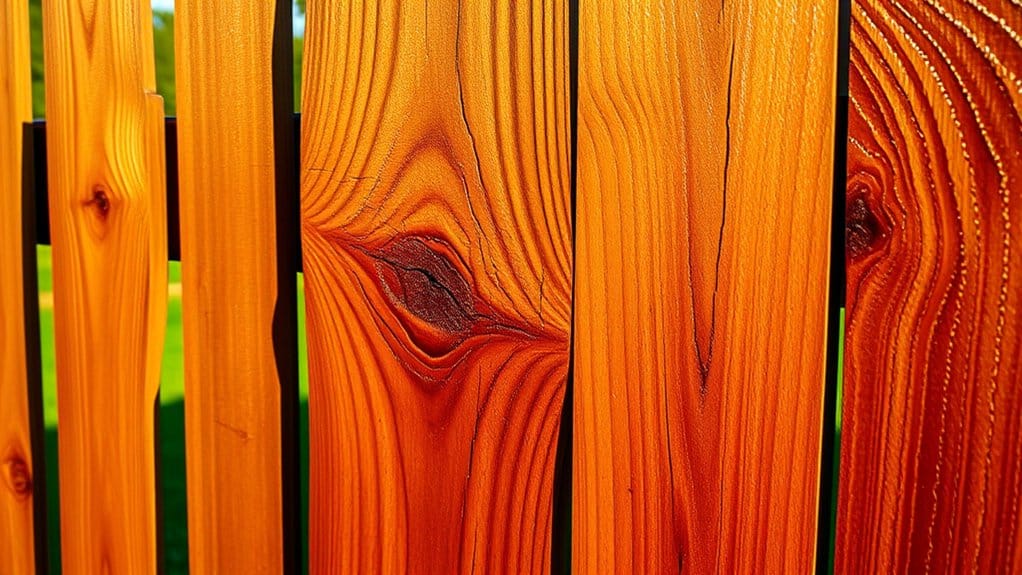
When you need a strong and versatile fencing material, Douglas Fir is an excellent option. Here’s why:
- Heavy-duty strength ensures durable fencing.
- With proper care, it can last 20 to 30 years.
- It features a smooth finish and attractive grain.
- Works well in various climates and styles.
- Sourced sustainably, supporting eco-friendly practices.
Douglas Fir not only beautifies your outdoor space but also meets your structural needs effectively.
Although it requires some maintenance, its long-lasting value makes it a wise investment.
Choose Douglas Fir for dependable fencing!
Frequently Asked Questions
What Factors Influence the Cost of Wood Fencing Installation?
When planning wood fencing installation, consider labor costs and the quality of materials. For example, investing in higher-quality wood might cost more initially but can reduce maintenance expenses and last longer, saving you money over time.
How Do Local Climate Conditions Affect Wood Choice?
When selecting wood, consider your local climate as a key factor. The durability of wood is influenced by moisture, heat, and UV exposure. For instance, in humid areas, opt for rot-resistant woods like cedar or redwood. In sunny regions, choose woods with good UV resistance to avoid fading. Your choice can mean the difference between a long-lasting fence and one that deteriorates quickly.
Can I Mix Different Wood Types in My Fence?
Yes, you can mix different wood types in your fence. Using a combination of durable woods can boost the visual appeal and longevity of your fence. For example, pairing cedar with pressure-treated pine can create an attractive look while ensuring stability. Just remember to maintain a balance between style and function for a cohesive result.
What Is the Best Way to Treat Wood Before Installation?
Before installation, it’s important to preserve wood through cleaning, debarking, and applying treatments. These steps help prevent moisture damage and extend the wood’s lifespan, acting like armor for your fence against the elements.
Are There Eco-Friendly Options for Wood Fencing?
Absolutely, there are eco-friendly choices for wood fencing! Look for FSC-certified lumber or reclaimed wood. These materials are sourced sustainably and recycled, helping to reduce environmental impact while adding charm to your property.
Conclusion
Choosing the right wood for your fence can be tricky. Whether you go for the beautiful Coastal Redwood or the affordable Norway Spruce, each type has its own maintenance needs. While you might love the look of your choice, be prepared for some upkeep. Ultimately, picking the right wood means committing to a fence that looks good but may require attention over time.

